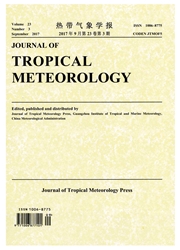

 中文摘要:
中文摘要:
The planetary wave response to global warming with single forcing of greenhouse gases (GHGs) is investigated in this study by using a total of 11 model results that anticipated CMIP3 4×CO2 experiments. It is shown that the amplitudes of the planetary wave fluxes over Siberia, the Eastern North Pacific, and the North Atlantic decrease by approximately -10% to -30% in the warming context. In particular, the vertical wave flux over the Eastern North Pacific significantly decreases by -28.6%. The weakening of the planetary waves is partly associated with the decreased land-sea thermal contrast, which may be caused by the radiation effect of CO2 and the different surface heat capacities of land and sea. The present work provides a clear understanding of the responses of planetary waves to GHGs forcing.
 英文摘要:
英文摘要:
The planetary wave response to global warm ing with single forcing of greenhouse gases (GHGs) is investigated in this study by using a total of 11 model results that anticipated CMIP3 4XCO2 experiments. It is shown that the amplitudes of the planetary wave fluxes over Siberia, the Eastern North Pacific, and the North Atlantic decrease by approximately -10% to -30% in the warming context. In particular, the vertical wave flux over the Eastern North Pacific significantly decreases by -28.6%. The weakening of the planetary waves is partly associated with the decreased land-sea thermal contrast, which may be caused by the radiation effect of CO2 and the different surface heat capacities of land and sea. The present work provides a clear understanding of the re sponses of planetary waves to GHGs forcing.
 同期刊论文项目
同期刊论文项目
 同项目期刊论文
同项目期刊论文
 期刊信息
期刊信息
